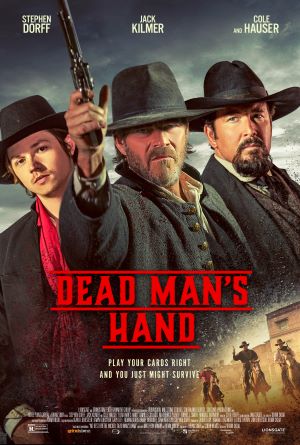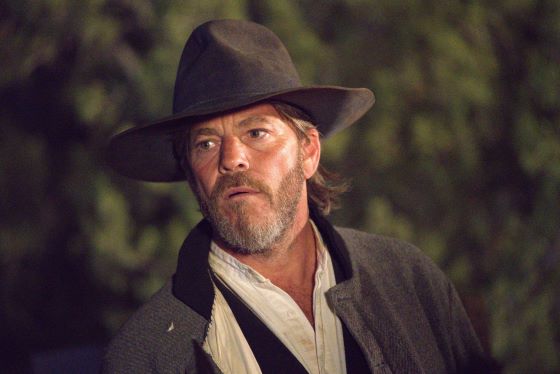

[Rating: Rock Fist Way Down]
In Theaters, On Demand, Digital July 7
Movies as bad as Dead Man’s Hand usually come with an obvious explanation, but many of them fail to offer compelling or sensible elucidation for this. Sure, it’s got 18 producers, continuity errors, choppy editing, flat lighting, and regional-community-theater performances, but it also appears to have trained professionals on both sides of the camera and a budget that indicates someone notable had faith in all of this. That’s not usually the case with the usual suspects in these instances: the outright vanity projects, amateur backyard cinema experiments, or money-laundering tax shelters masquerading as movies—any of which would have been preferable to what is presented here.
No, Dead Man’s Hand is a special, unique flavor of terrible.
The film opens inside a Nevada-bound stagecoach containing young gunslinger, Reno (Jack Kilmer), his new bride, Vegas (Camille Collard), and a woman with two kids. A band of former Confederate soldiers attacks the group in transit, yet this threat is casually murdered away by Vegas and Reno, the former of whom brushes off a suggestion that they leave the bodies because he, “don’t let no man rot.” Instead, Reno elects to drag two of the corpses behind the stagecoach into town: an act arguably more disrespectful and destructive than if they’d just been left to fester.
This macabre announcement of their arrival incurs the wrath of the town’s mayor, Clarence Bishop (Stephen Dorff), who is the brother of one of the cheese-grated meat sacks splayed out on Main Street. Vegas and Reno’s arrival also coincides with the work of a U.S. Marshall (Cole Hauser) that’s trying to bring Bishop before a judge on a semi-related warrant, yet can’t seem to crack the shield of hired muscle surrounding the guy. Although Bishop is able to strike first and put both men on their heels, the Marshall and Reno team up with a little assistance from a local Apache tribe to take the fight to the baddie.

Co-writer, director, editor, and producer Brian Skiba doesn’t just make a mess of the production with the lighting, blocking, pacing, actor-coaching, and action staging, but the basics, too. Continuity errors abound not just onscreen (Reno has a gun in hand as he reaches down to pick something up, then doesn’t in the next shot) but in the script as well. At one point, in a Wiseau-esque moment of inspiration, Reno asks someone where “you two are going,” even though there’s three people opposite him.
It’s stunning, really, but what pushes Dead Man’s Hand from merely bad to bracingly awful is Skiba and the film’s failure to connect with any trope, motif, or symbol of the Western genre in a deliberate or meaningful way. The laziness of the production and script is one thing, but to present a Western protagonist in all black (hat included) without subverting tropes or playing with that iconography says a lot about the slapdash nature of the whole affair. Watching the movie, it doesn’t just feel uninspired: closer inspection reveals that it is unmoored from any semblance of care or concern about the material on either a micro or macro level.
It’s just awful from top to bottom. The action is clumsily staged and uninspired, relying on stormtrooper accuracy and plot armor during every shootout or melee. There’s varying levels of effort from the cast, which peak with Collard and Dorff and crater out with Hauser, who should be credited as “Rip Wheeler” since he’s just playing a lawman version of his Yellowstone character here. The history the movie calls on with its Confederate villains and Apache allies also demonstrates a complete lack of knowledge and/or understanding of the time/place presented, which might be the reason the script never specifies precisely when/where this is taking place.

Indeed, keeping it nebulous might have been the smart move since there isn’t a location post-Civil War yet pre-20th century that had Apache living in teepees in a Chihuahuan desert with concentrated Confederate resistance cells nearby. And really, none of that would be enough to sink the movie if it had engaging characters, an interesting narrative backbone, fun action, genre familiarity, striking visuals, brisk pacing, or basic continuity … which it doesn’t. Hell, a western doesn’t have to be historically accurate, grounded in good physics, rich in character, pleasant to look at, or even fun—but it ought to at least be one of those things.
There’s a battle going on right now with the Hollywood writer’s union, and one of the main issues is the use of A.I. in script writing, which could conceivably replace knowing thought and creativity with algorithm-based story points. Watching this movie, one wonders if the fight is worth it if the present output is as lifeless, bland, disconnected, and rote as this drivel. That seems rough, but bad movies can bring out the darkest impulses in people (even hack movie critics). Here’s hoping the flesh and blood writers do win out in the end, even if movies like Dead Man’s Hand are the price of doing human business.





Comments on this entry are closed.